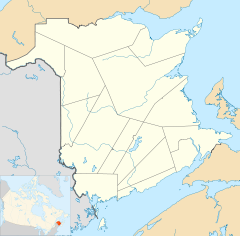- Chipman, New Brunswick
-
Location of Chipman in New Brunswick
Chipman (2006 population: 1,291) is a Canadian village in Queens County, New Brunswick.
The village of Chipman is located on the banks of the Salmon River at the head of the Grand Lake, the largest freshwater lake in the Maritime provinces. The village itself is located around 73.4 kilometres from the capital city of Fredericton.
History
The village of Chipman was founded in 1835, and was made up of portions of the older parishes of Brunswick and Canning. The first settler in what would become the Parish of Chipman was Alexander McClure of County Tyrone, Ireland, who arrived in 1820 with his wife, Mary McLeod, and their five daughters. Earlier settlements upriver at Gaspereux, and downriver at the Range, existed prior to 1820, consisting of local settlers and Maine businessmen who established the first sawmills on the Salmon and Gaspereux Rivers. Immigration to the Chipman area escalated rapidly in the 1820s through the 1850s, with the large majority of new arrivals hailing from the northern counties of Ireland, in particular: Donegal, Londonderry, and Tyrone. The rapidly growing lumbering and sawmill industries were the primary impetus for this growth, which continued through most of the 19th century. The Parish of Chipman quickly became prominent because of its large population in comparison with the surrounding parishes, aided by the lure of employment from the burgeoning lumbermills, the coming of the railways, the development of the coal mining industry, and later in the 1930s, the establishment of L.E. Shaw’s brick and tile plant.
The first census, taken pre-Confederation in 1851, has not survived. The 1871 census, taken the year the first sawmill was established in Chipman proper, showed that the parish contained some 1,765 people. Compared to the nearby parishes of Brunswick and Cambridge, this was 1,315 and 267 more residents, respectively. By the late 19th century, Chipman and its surrounding area boasted several lucrative lumber mills, large company stores, shipyards, a large scale coal mining industry, covered bridges, a bank, a grocer, a hospital, a cheese factory, a post office, a grist mill, several churches, schools and other businesses, and a passenger and cargo railway. By 1881, the population had maintained itself, and the census recorded numbers of 1,772. Throughout most of the 20th century, Chipman also benefitted from a coal mining boom.
Despite its prosperity, economic growth in the late 19th and early 20th centuries was insufficient to provide employment for all the population at a time when families typically produced several children. As a consequence, Chipman experienced its own exodus of surplus labourforce, particularly young men who had gained valuable experience in lumbering and milling. Chipman-area natives became pioneering founders of the embryonic sawmill industries in Montana, Washington State and California, as well as leading businessmen in other ventures in the new western U.S. territories and states.
References
There have been several books published about the history and folklore of Chipman and the surrounding area:
Baird, Rev. Frank, M.A., D.D., 1946. History of the Parish of Chipman. Sackville, NB: Tribune Press Ltd.
Baird, Rev. Frank, M.A., D.D., 1941. Salmon River One Hundred Years Ago - An Address at the Centennial Celebration of the Chipman United Church.
Chipman Historical Photo Committee, eds. 2002. Chipman Then and Now: A Pictorial History of Chipman and Neighbouring Communities. Chipman: Mirror Printing.
Copeland, Gary. 1992. Men of Clay, The Chipman Story: A Historical Biography of the Chipman Brick Industry ( 1928–1990). St. Stephen, NB: Data I.
Morell, Marjorie Taylor. 1981. Of Mines and Men. St. Stephen, NB: Print’N Press.
Gillett, Heather Roselle. 2008. "What is a Brickmaker: An Occupational Folklife Study of the Brick Industry in Chipman, New Brunswick." MA Thesis (Folklore). St John’s, Memorial University of Newfoundland.
Categories:- Communities in Queens County, New Brunswick
- Villages in New Brunswick
Wikimedia Foundation. 2010.

